Mission Summary
20090819N1 Aircraft 49RF
TDR/RI/SALEX Mission about Hurricane Bill 2009
Aircraft Crew (49RF)
| Aircraft Commander | Will Odell |
| Co-pilot | Greg Glover |
| Flight Director | Jackie Almieda |
| Flight Director | Nancy Ash |
| Electronics Technician | Mark Rogers |
| AVAPS Operator | Steven Paul |
| AVAPS Operator | Dale Carpenter |
Scientific Crew (49RF)
| Dropsonde Scientist | Jason Dunion |
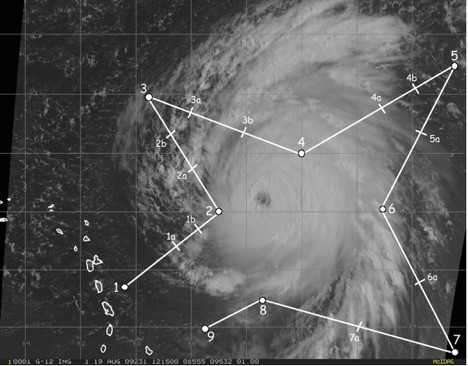
|
|
Fig. 1: Flight track (white line) for TDR/RI/SALEX mission 20090819N1
overlaid on GOES visible imagery from 1215 UTC. The GPS dropsonde points
(20 total) are indicated by white circles and hash marks.
|
Mission Plan :
NOAA 49RF will fly a combination TDR mission, Rapid Intensity (RI) Experiment
and Saharan Air Layer Experiment (SALEX) around Hurricane Bill. The G-IV will
leave Barbados at 0750 UTC and will recover back at Barbados at 1426 UTC. The
flight track will take the G-IV on a clockwise circumnavigation of the TC and
is shown in Fig. 1, along with the 20 GPS dropsonde points.
Mission Summary :
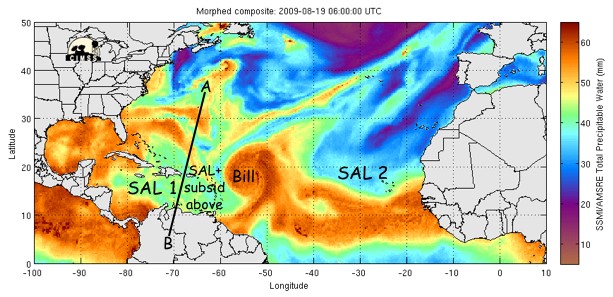
|

|
|
Fig. 2: (Top) TPW imagery (19 Aug 0600 UTC) showing Hurricane Bill and
two large SAL outbreaks (green to blue shading; ≤45 mm TPW) located east,
north and west of the storm. The black line labeled "A" and "B" shows a
coincident CALIPSO satellite overpass. (Bottom) Cross section of aerosols
detected by a 0622-0645 UTC CALIPSO overpass along the transect labeled
"A" and "B" in the TPW image.
|
a) Synoptic Situation
On 19 August 1200 UTC, Hurricane Bill was a minimal category 4 hurricane
(115 kt) located at ~18.4°N 55.6°W (Fig. 2) and positioned between two
large Saharan Air Layer (SAL) air masses. Figure 2 (bottom) also shows that
the SAL air mass wrapping around the western semicircle of Hurricane Bill
contained a significant amount of dust from the near-surface up to ~5 km.
The storm was tracking 295-300 degrees at 14 kt around the southern periphery
of a deep layer ridge [Fig. 3 (left)]. Also at this time, a trough was
continuing to amplify over the central U.S. and a weakness and a weakness was
developing in the ridge NNW of the storm. Bill was located in a region of
increasing westerly shear (10-20 kt, Fig. 3, right). Based on dropsonde data
from the missions and GOES satellite winds (Fig. 4), the 20+ kt of vertical
wind shear indicated in Figure 3 (right) was likely an artifact of the vortex
removal process. Given the skewed E-W symmetry of the vortex at this time
[more (less) restricted around the western (eastern) semicircle], some of the
upper-level outflow associated with the storm may not have been sufficiently
removed on the eastern side of the storm during the vortex removal.
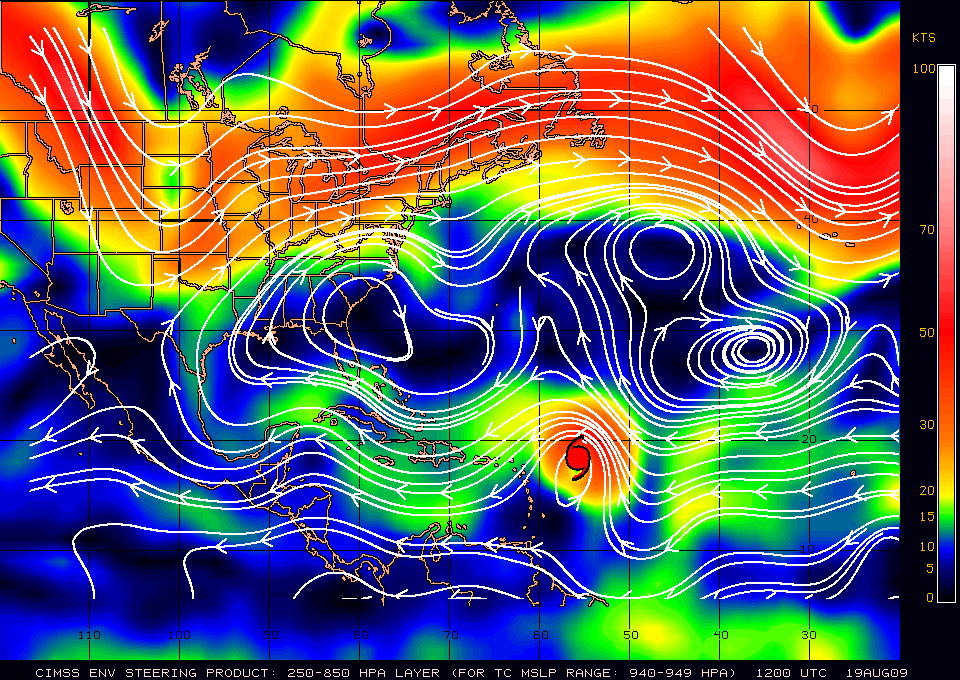
|
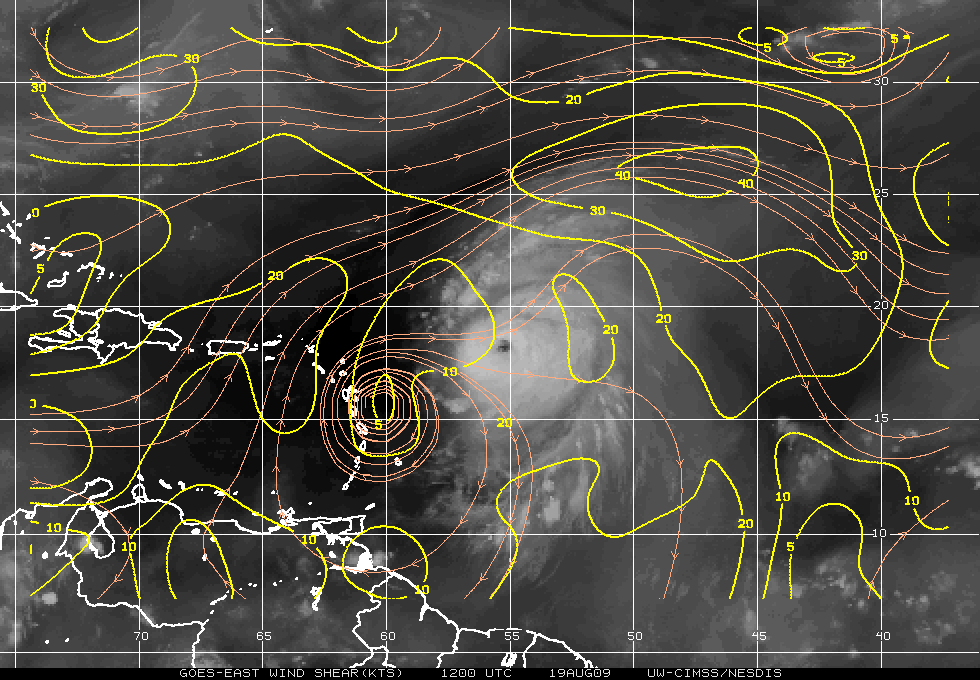
|
|
Fig. 3: Plots of (left) 250-850 mb deep layer mean steering [magnitude
(direction) of the steering flow is indicated by colored shading (white
streamlines] and (right) vertical wind shear for 19 August 1200 UTC.
Images courtesy of UW-CIMSS.
|
GOES low-level cloud drift winds indicated strong (25-30 kt) winds around the
periphery of the northern semicircle of the storm (Fig. 4, left). GOES water
vapor winds also indicated that the upper-level outflow pattern was not as
favorable as it had been the previous day. Upper-level winds were generally
cyclonic in the NW, SE and NE quadrants of the storm. The north side of the
storm had the most unrestricted outflow, though there was also some weak
(10-20 kt) anticyclonic outflow to the SW (Fig. 4, right). TPW imagery
indicated that a SAL intrusion was continuing to wrap into the storm in the
southwest quadrant and was even beginning to impinge on the SE quadrant
(Fig. 2 (top), Fig. 5).
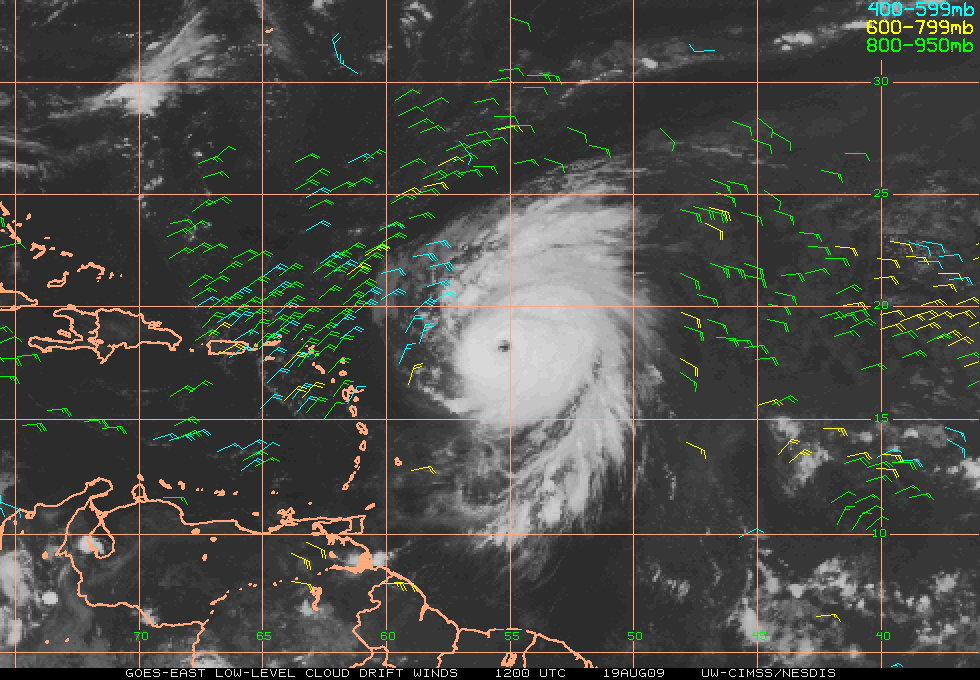
|
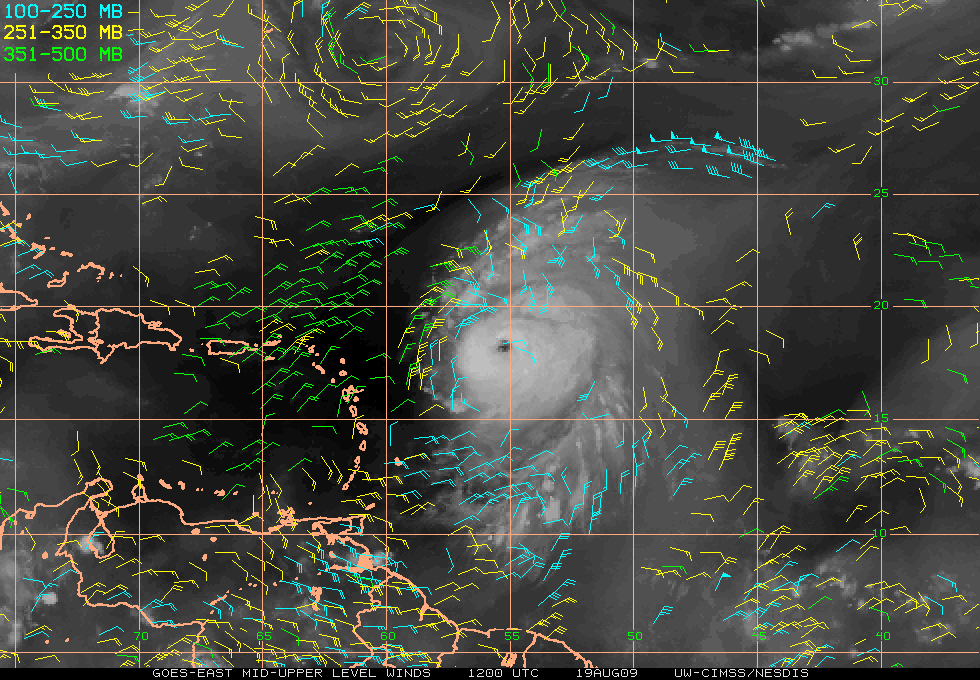
|
|
Fig. 4: Plots of (left) GOES low to mid-level cloud drift winds and
(right) mid to upper-level water vapor winds for 19 August 1200 UTC. Images
courtesy of UW-CIMSS.
|
b) Mission Specifics
The flight plan was designed to investigate Hurricane Bill with targeted
sampling of SAL air masses positioned NE, NW and SE of the storm and the
moist tropical environment associated with the storm (Figs. 2 & 5). TPW
values of ≤45 mm (>45 mm) were used to discern the SAL (moist tropical)
environments around the storm. The G-IV star pattern that was flown was a new
flight pattern that was designed to sample the environment surrounding the
storm and the possible penetration of that environment in toward the "inner
core" region. Extra GPS dropsonde sampling along the "radial" legs of the
starfish pattern were designed to observe this transitional environment and
improve our understanding of how the surrounding environment may or may not
be impacting the "inner core" of the storm. Takeoff was at 0750 UTC from
Barbados. The flight plan called for a clockwise sampling of the storm at an
optimal flight level of 41,000-45,000 ft. Main targets included the SAL 1 air
mass NW and SW of the storm, the SAL 2 air mass NE of the storm, the SAL
intrusions that was advecting into the SW and SE quadrants, the moist tropical
atmosphere close to the "inner core" region and the transitional environment
between the SAL and the "inner core" environments. A dropsonde launched NW of
the storm (drop # 3) indicated a dry SAL air mass that was topped by a deep
layer of dry subsiding air. This dropsonde also indicated a 30-35 kt NE jet
at ~925 mb. Drop # 3b, located ~170 nm NNW of the center, showed a dry wedge
from ~600-950 mb and a 60 kt ENE wind max near 880 mb. It is unclear where
this dry air originated, though it is likely that it was associated with either
the SAL outbreak to the east or was a filament of the dry SAL intrusion that
was advecting around the SW and SE sides at the time. Drop # 5, located NE of
the storm sampled the SAL outbreak east of Hurricane Bill indicated dry SAL air
from ~600-850 mb, a 1.5°C temperature inversion at the SAL base, and a 30
kt easterly jet at 600 mb. Drop # 8 (~215 nm south of the center) observed the
dry SAL intrusion that was wrapping around the SW and SE quadrants and showed
that dry SAL air was located under the CDO. Additionally, a 35 kt SSW jet at
~675 mb was collocated with this dry air and apparently promoting its advection
around and into the storm.
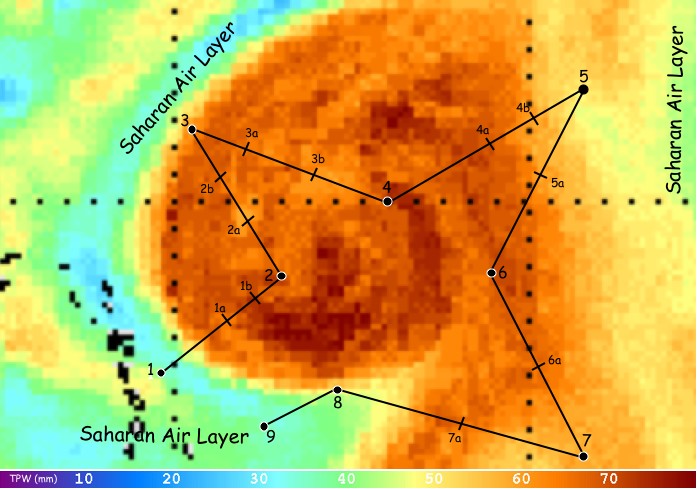
|
|
Fig. 5: TPW imagery showing Hurricane Bill on 19 August 1200 UTC. The
SAL's dry air is indicated by values of ≤45 mm (green to blue shading) in
the TPW image. The G-IV flight track (black curve) and dropsonde points
(black circles and hash marks) are overlaid for reference. Imagery courtesy of
UW-CIMSS.
|
Problems :
There were no major problems related to this flight. Twenty-one GPS dropsondes
were deployed during the mission, one of which was a fastfall.
Mission Data :
Drop log
Page last updated October 13, 2009
Return to Mission page.

